Plastic toothbrushes are one of the most widely used personal hygiene products across the globe. With growing awareness of oral hygiene, the demand for plastic toothbrushes has surged dramatically. Whether it’s for children, adults, or functional needs users, toothbrushes are a daily necessity. If you’re considering starting a plastic toothbrush manufacturing business, this comprehensive guide will walk you through the process step-by-step. From raw materials to marketing strategies, we cover it all. The keyword plastic toothbrush will be discussed in-depth to help you understand the nuances of this evergreen product market.
Understanding the Plastic Toothbrush Manufacturing Process
To begin with, it is essential to understand that toothbrushes are a blend of design, ergonomics, and material science. A plastic toothbrush typically comprises a plastic handle and nylon bristles. The production process involves several steps including material selection, molding, tufting, trimming, packaging, and quality control.
1. Raw Materials Required
The major raw materials required to produce a plastic toothbrush are:
-
Plastic Granules: Usually polypropylene (PP) or polyethylene (PE) for handles due to their lightweight and moldability.
-
Nylon Bristles: Commonly nylon-6 or nylon-6.6, known for their flexibility and durability.
-
Color Pigments: To add variety to the toothbrush handle and make them visually appealing.
-
Packaging Material: Blister packs, cartons, or plastic pouches.
The quality of raw materials directly impacts the final product. Sourcing from reliable vendors ensures consistency in toothbrush performance.
2. Machinery and Equipment Needed
For plastic toothbrush manufacturing, several key machines are required:
-
Injection Molding Machine: Used to mold plastic granules into handle shapes.
-
Tufting Machine: Implants bristles into the holes of the plastic handle.
-
Trimming Machine: Cuts bristles uniformly to ensure evenness and softness.
-
Polishing Unit: Smoothens the toothbrush head and removes sharp edges.
-
Packaging Machine: Automates the packing process to increase output.
Investing in semi-automatic or fully automatic machines depends on your production capacity and budget.
3. Step-by-Step Manufacturing Process
The manufacturing of a plastic toothbrush includes multiple coordinated steps. Here’s how it unfolds:
a. Handle Molding
Plastic granules are heated in the injection molding machine and injected into molds. After cooling, the mold opens to eject the formed plastic toothbrush handles.
b. Bristle Tufting
This step involves inserting nylon bristles into the head of the toothbrush. Modern machines use the staple-and-tuft method, ensuring bristles stay firmly in place.
c. Trimming & End Rounding
Bristles are trimmed to uniform length and shaped for specific uses (flat, wavy, zig-zag). End rounding is essential to make the bristles safe for gums.
d. Polishing and Finishing
Polishing removes burrs or sharp edges. Some toothbrushes undergo laser engraving for branding.
e. Cleaning and Sterilization
The finished plastic toothbrushes are cleaned and sterilized before packaging to ensure hygiene.
f. Packaging
Toothbrushes are then individually packed using blister packs or eco-friendly alternatives and boxed in bulk for shipment.
4. Cost of Setting Up the Manufacturing Unit
The cost varies depending on the scale of operation. Here’s a rough estimate:
-
Small Scale: ?10 – ?15 lakhs
-
Medium Scale: ?25 – ?50 lakhs
-
Large Scale: ?1 crore and above
Costs include machinery, raw materials, factory setup, labor, and utilities. Operating costs like electricity, water, maintenance, and salaries also need to be accounted for.
5. Location and Infrastructure
The manufacturing unit should ideally be located in an industrial zone with access to electricity, water, and transportation. Space requirements can range from 1000 to 3000 square feet depending on your production capacity. Good ventilation and hygiene are critical, especially if you aim for ISO or FDA certifications.
6. Manpower Requirements
A small-scale plastic toothbrush manufacturing unit typically requires:
-
2-3 machine operators
-
2 helpers for material handling
-
1 quality control supervisor
-
1 packaging and logistics staff
-
1 manager/admin
Proper training must be provided to ensure operational efficiency and product quality.
7. Quality Control and Standards
Quality plays a vital role in customer retention and brand image. Some important quality checks include:
-
Bristle Pull Test: Ensures bristles are firmly attached.
-
Handle Strength Test: Prevents breakage during use.
-
End Rounding Check: Protects gums from injury.
-
Sterility Test: Confirms the product is hygienically safe.
Certifications like ISO 9001 (Quality Management) and ISO 13485 (Medical Devices) can boost credibility.
8. Marketing and Sales Strategy
Once you have a ready product, focus on branding and marketing. Here are some effective strategies:
-
Create a Brand: A memorable name and packaging design go a long way.
-
B2B Channels: Distribute to wholesalers, dental clinics, hospitals, and pharmacies.
-
Online Platforms: Sell through Amazon, Flipkart, and your own e-commerce site.
-
Social Media Marketing: Promote your plastic toothbrush through Instagram and Facebook.
-
Bulk Export: Consider exporting to developing countries with high demand.
Offline and online efforts should be synchronized for maximum reach.
9. Environmental Concerns and Alternatives
Traditional plastic toothbrushes contribute to plastic waste. To stay competitive and socially responsible:
-
Explore biodegradable or bamboo handles with nylon bristles.
-
Use recyclable packaging.
-
Highlight eco-conscious branding to appeal to green consumers.
Governments are tightening environmental norms, so adopting sustainability practices early on is a smart move.
10. Challenges and Risk Management
Some common challenges in the plastic toothbrush business include:
-
High Competition: Many local and global players.
-
Price Sensitivity: Consumers often buy based on price.
-
Supply Chain Issues: Raw material cost fluctuations can affect profitability.
-
Changing Regulations: Eco-friendly compliance is becoming stricter.
Mitigation strategies involve diversifying product lines (e.g., electric toothbrushes, kids’ variants), building brand loyalty, and maintaining a lean supply chain.
11. Future Scope of the Industry
The toothbrush industry is expected to grow steadily due to increasing awareness of oral care and lifestyle improvements. Innovations in bristle technology, ergonomic designs, and sustainable materials are on the rise. Venturing into premium toothbrush segments or subscription models can further enhance revenue.
Developing countries like India, Brazil, and parts of Africa are large untapped markets. Additionally, collaborations with dental clinics for co-branded products could open new sales channels.
Conclusion
Starting a plastic toothbrush manufacturing business can be a profitable venture when planned and executed carefully. From acquiring quality raw materials to installing efficient machines, every step plays a crucial role in producing a product that stands out in the market. With a focus on quality, hygiene, and branding, manufacturers can tap into a consistent demand curve. Moreover, embracing eco-friendly innovations and staying ahead of industry trends will ensure long-term sustainability and growth. Whether you’re an aspiring entrepreneur or an established manufacturer diversifying into oral care, plastic toothbrush production presents a rewarding business opportunity in today’s consumer-driven world.
Visit the page Select and Choose the Right Business Startup for You for sorting out the questions arising in your mind before starting any business and know which start-up you can plan. We, at NPCS, endeavor to make business selection a simple and convenient step for any entrepreneur/startup. Our expert team, by capitalizing on its dexterity and decade’s long experience in the field, has created a list of profitable ventures for entrepreneurs who wish to diversify or venture. We regularly update the list to give you a steady dose of new emerging opportunities.




